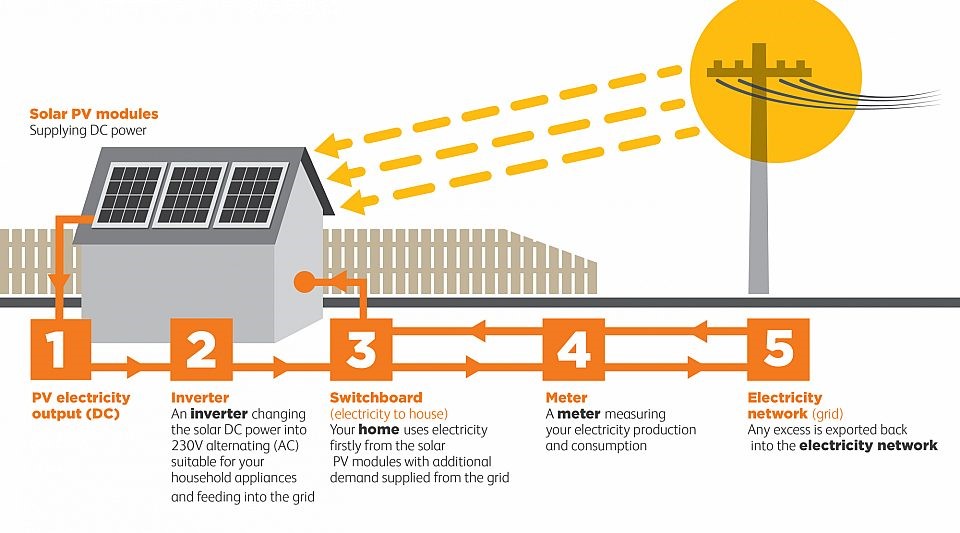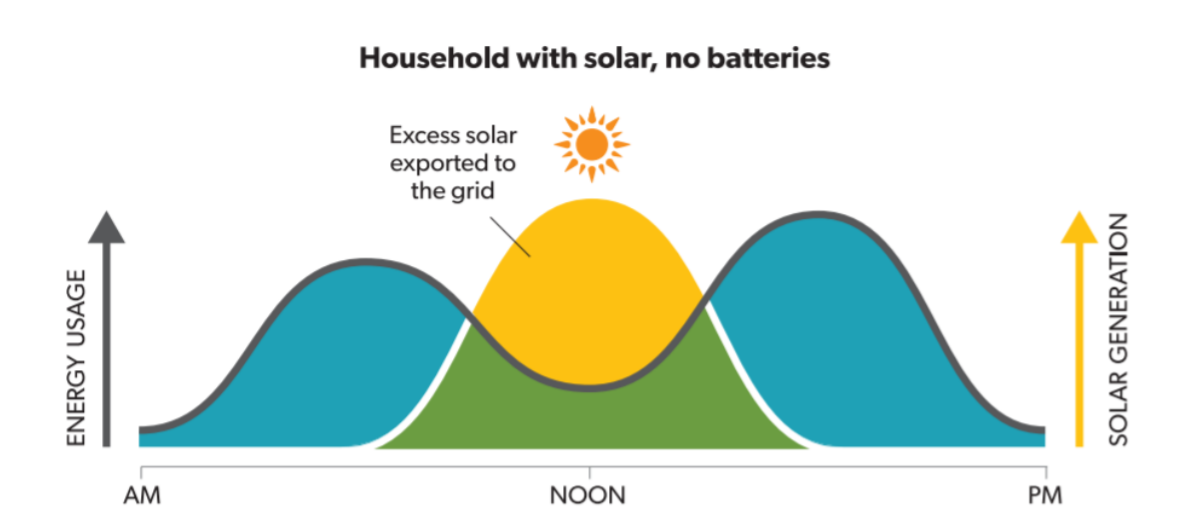Why go solar?
With solar panels you can access free clean energy, reducing your energy bills while doing your bit to respond to the climate emergency.
The price of solar has continued to drop year after year, and many households are eligible for State Government rebates. Solar will typically ‘pay for itself’ in 3-5 years. You'll start seeing savings on your bills right away. A typical system lasts around 25 years, so your solar system will continue to save you money long after the payback period.
How does solar work?
Your solar photovoltaic (PV) system generates electricity when the sun shines. If you use the energy when it's being generated, you are using free, renewable energy. Any excess electricity is fed into the power lines in the street that make up the electricity grid, where it can be used by other households.

Image source: Clean Energy Council
When you use your solar while the sun is shining, you're saving the cost of electricity you would otherwise buy from the electricity grid. When you export excess electricity to the grid, you receive a feed-in-tariff – a credit on your bill. The price you pay for electricity, and the feed-in-tariff you receive, will both depend on your electricity retail offer, but the cost of buying electricity from the grid is higher than the feed-in-tariff you receive for exporting electricity. This means your savings will be greater if you use electricity during the day.
Increasingly, some households are not able to export electricity to the grid and receive the feed-in-tariff. As more solar is added to the grid, there is not always enough capacity in some local areas. Your solar system can only export energy to the grid with approval from the local electricity distributor.
You may find out that your new solar system will be restricted from exporting energy to the grid after paying a deposit for a solar installation. In rare cases, you may find this out after the system has been installed. Since the electricity distributor, not the solar company, makes this decision, it’s not always possible to know beforehand. You may wish to consider the financial implications of not receiving the feed-in-tariff, and ways you can shift your energy usage to daytime to maximise your savings.

Image source: NSW Government Solar System Factsheet for Households and Businesses
Solar hot water systems use energy from the sun to heat water for your household. This guide is not about solar hot water, but about solar photovoltaic (PV) systems, which use solar panels to generate electricity.
Is solar right for you?
Over 2.5 million Australian homes, including thousands in Yarra, have already installed solar and are saving on energy bills by using energy from the sun. With the right size system, many households save 30-60% on their household energy bills by using solar. And if energy prices rise, you’ll still have access to free electricity while the sun is shining.
Ask yourself these questions:
- Do you own your home? If you’re a homeowner, it’s straightforward to go solar.
- Do you rent your home? There are options for renters including rebates that help renters and landlords share the benefit. See our solar guidance for renters and landlords.
- Is your home freestanding (or semi-detached)? If so, and you don't have a strata title, choosing solar is a simple decision for you and your family. If you live in a one- or two-storey home with a strata title, you still may be able to put solar on your roof, with approval from your owner’s corporation. If you live in an apartment or unit, read our solar guidance for apartments.
- Do you use mainly use energy during the day? You’ll save most with solar if you use energy when it’s generated during the day. If no one is home during the day, check to see if appliances like the washing machine, clothes dryer and dishwasher have timers. You can also buy appliance timers to shift your electricity usage to daytime. If you’re one of the many people who are working from home more than you used to, you may now be using more energy during the day.
- Is your home included in a heritage overlay? Find out if your home is in a heritage overlay and you will need a planning permit to install solar. Read our guidance on preparing a planning permit application for installing solar panels on a property in a heritage overlay. Contact statutory planning staff at [email protected] or call 03 9205 5555 for more information about planning permits and heritage overlays
Take a look at your roof:
- Is there space on the north, east or west-facing side? For example, a 4 kilowatt (kW) solar system will have 12-16 panels, and take up approximately 30 square metres of space. Find out how many panels will fit on your roof using the free SunSPOT solar calculator.
- North-facing solar panels generally produce the most electricity, but east- and west-facing panels are almost as efficient. Solar installed on the southern side will produce the least energy.
- Is your roof in good condition? A solar PV system lasts around 25 years or more, so roof repairs need to be completed before installing solar. Solar can be installed on most types of roofing, except slate.
- How steep is your roof slope? Solar is most easily installed on or moderately sloped or flat roof.
- Is your roof shaded by nearby trees or buildings? You’ll need enough sunny space on your roof to install solar. Microinverters or power optimisers can help if your roof is partially shaded. The free SunSPOT solar calculator can show you the sunniest areas of your roof.
